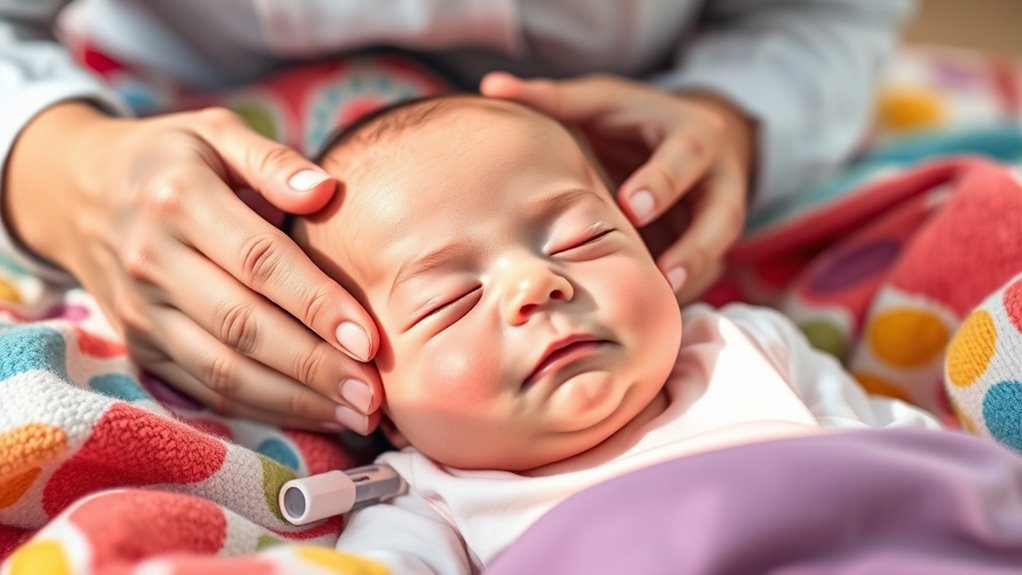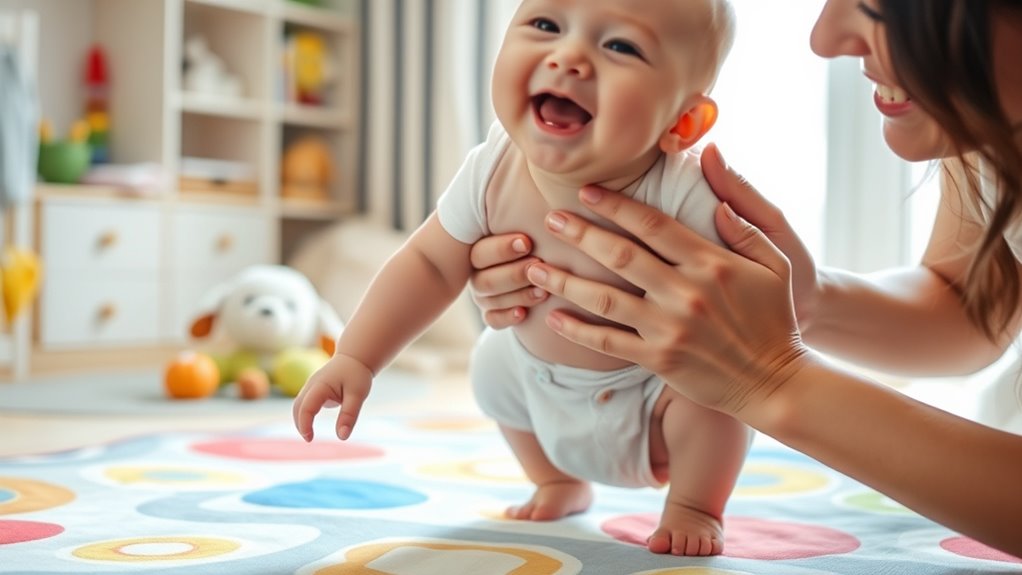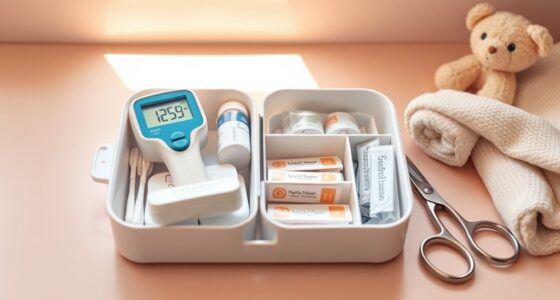If your baby is choking, stay calm and act quickly—perform age-appropriate back blows or chest thrusts and call emergency services if they can’t breathe. For fevers, monitor their temperature with a digital thermometer, offer fluids, and dress them lightly; seek medical help if the fever is over 104°F or persists. When your baby falls, check for injuries, remove hazards, and supervise closely to prevent future falls. Continue exploring these essential first aid steps to keep your little one safe.
Key Takeaways
- Recognize choking signs like coughing or bluish lips and perform age-appropriate first aid immediately.
- Use a digital thermometer to monitor fever and offer fluids; seek medical help if temperature exceeds 104°F or persists.
- Babyproof your home by securing furniture, covering sharp edges, and keeping small objects out of reach to prevent falls and injuries.
- In case of a fall, cushion the area with soft mats and supervise closely during playtime near stairs or elevated surfaces.
- Maintain safety awareness daily, including fire hazards, safe handling of heat sources, and using safety gates to prevent accidents.
Recognizing and Responding to Choking Incidents

Choking can happen suddenly and is a serious emergency that requires immediate action. As a caregiver, recognizing the signs of choking—such as coughing, gagging, or bluish lips—is essential. Stay calm and act quickly. Keep your emergency kit essentials nearby, including a flashlight and gloves, to help manage the situation safely. Babyproofing tips, like keeping small objects out of your baby’s reach, can prevent choking hazards. If your baby is choking and unable to breathe, perform age-appropriate first aid, such as back blows and chest thrusts. Remember, swift response can save your baby’s life. Practice these techniques regularly and make sure your emergency kit is stocked with the necessary supplies. Being prepared helps you respond confidently when every second counts. Familiarity with best first aid practices can make all the difference in an emergency.
Managing Fever and When to Seek Medical Help

When your baby develops a fever, it’s important to monitor their symptoms carefully to determine if medical help is needed. Keep an eye out for signs like a high temperature, persistent crying, difficulty breathing, or lethargy. Effective fever management includes using a digital thermometer to check their temperature, offering plenty of fluids, and dressing them in lightweight clothing. Know when to seek medical help, such as if their fever exceeds 104°F (40°C), lasts more than a couple of days, or if they show signs of distress. Remember, prompt action can prevent complications. Trust your instincts and don’t hesitate to consult a healthcare professional if you’re unsure whether your baby’s symptoms require urgent care. Your quick response ensures their safety and comfort.
Safely Handling Falls and Preventing Injuries

Falls are a common part of a baby’s development, but preventing injuries requires constant vigilance and safe practices. Baby proofing hazards around your home is essential—cover sharp edges, secure furniture, and lock cabinets to minimize risks. Always supervise your baby during play and exploration, especially near stairs or elevated surfaces. When your baby starts to crawl or walk, use safe fall techniques by cushioning the floor with soft mats or rugs in high-risk areas. Teach your little one to sit or crawl carefully and avoid rushing or overestimating their abilities. Regularly check your environment for potential hazards, and stay attentive to your baby’s movements. Additionally, understanding candle melting conditions can help prevent accidents related to heat and fire hazards in your home. Being aware of sound vibrations and their effects can also contribute to creating a calming and safe environment for your child. Incorporating safety awareness into daily routines helps reduce fall-related injuries and keep your little one safe as they learn and grow. Maintaining awareness of home safety measures is vital for creating a secure environment that minimizes fall risks. For example, using appropriate safety gates can further prevent accidental falls from stairs or elevated areas.
Frequently Asked Questions
How Can I Prevent Choking During Feeding Times?
To prevent choking during feeding times, you should follow safe feeding practices and choking prevention tips. Always supervise your baby closely, make certain food is appropriately sized—small and soft—and avoid giving hard or sticky foods. Keep your baby sitting upright during meals, and never rush feeding. These steps help reduce choking risks, making mealtime safer and more comfortable for your little one.
What Are Subtle Signs of a Fever in Newborns?
Did you know that up to 60% of fever cases in newborns show subtle symptoms? For fever detection, watch for signs like fussiness, sleepiness, or a flushed face. Your little one might not have obvious temperature increases, but these subtle symptoms are clues. Keep a close eye on changes in behavior or skin color, and remember, early recognition helps you act quickly to keep your baby safe and comfortable.
When Is a Fall Serious Enough to Need Emergency Care?
You should consider a fall serious enough to need emergency response criteria if your baby shows signs of severe baby fall severity. If they lose consciousness, won’t wake up, have persistent crying, or show difficulty breathing, seek emergency care immediately. Any fall resulting in a bump to the head with vomiting, unusual drowsiness, or difficulty moving warrants prompt medical attention. Trust your instincts and don’t hesitate to get professional help when in doubt.
How Do I Soothe a Baby With a High Fever at Home?
In the age of dial-up internet, soothing a baby with a high fever at home can feel overwhelming. You should use gentle home remedies and fever management techniques, like giving your baby plenty of fluids, dressing them in lightweight clothes, and using a cool, damp cloth on their forehead. Avoid overbundling and consult a doctor if the fever persists or worsens. Your calm approach helps ease your baby’s discomfort.
What Safety Equipment Can Reduce Fall Risks at Home?
You can reduce fall risks at home by implementing effective baby proofing measures and using safety equipment. Install guardrails on stairs, secure furniture to walls, and use safety gates to block access to hazards. Cover sharp corners with protectors, keep cords out of reach, and use non-slip mats in the bathroom and kitchen. These safety equipment and baby proofing measures create a safer environment, helping prevent potential falls and injuries.
Conclusion
Being prepared to handle common emergencies can make all the difference in your baby’s safety. Remember to stay calm, act quickly, and trust your instincts. With the right knowledge, you can turn panic into action and protect your little one during unexpected moments. Isn’t it comforting to know you have the power to keep your baby safe and secure, even in the most sudden situations? Trust yourself—you’ve got this.










